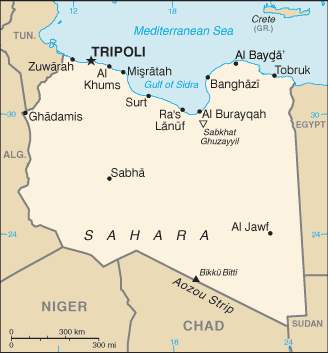|
Libya
|

|
Capital: Tripoli
Population: 6,777,452
Brief History of Libya:
The coast of Libya was a popular area for many of the great civilizations that grew up around the Mediterranean Sea. The first to arrive and build settlements were the Phoenicians and later the Carthaginians. Soon the Greeks and Romans moved in and conquered areas. Great cities were built during these times, but about all that is left of these cultures are the ruins they left.
In the 7th century AD, the Arabs conquered Libya. Most of the local people were converted to Islam and learned the Arabic language and culture. In the middle of the 16th century the Ottoman Turks invaded and Libya became part of the Ottoman Empire. They would stay in power until Italy invaded in 1911 and Libya became an Italian colony.
It was in 1934 that the name Libya was given to the Italian colony. Prior to that, Libya was what the Greeks had called all of North Africa besides Egypt.
On December 24, 1951 Libya declared independence. King Idris was the first King of Libya under the new government and constitutional monarchy. In 1959 Libya discovered large oil reserves. These reserves made the country very wealthy. However, the people were unhappy that all the wealth was going to an elite few people. In 1969 Mu'ammar Qadhafi led a rebellion and took over the government. Despite holding no official title in the Libyan government Qadhafi ruled Libya as supreme dictator until 2011 when he died.
The Geography of Libya
Total Size: 1,759,540 square km
Size Comparison: slightly larger than Alaska
Geographical Coordinates: 25 00 N, 17 00 E
World Region or Continent: Africa
General Terrain: mostly barren, flat to undulating plains, plateaus, depressions
Geographical Low Point: Sabkhat Ghuzayyil -47 m
Geographical High Point: Bikku Bitti 2,267 m
Climate: Mediterranean along coast; dry, extreme desert interior
Major cities: TRIPOLI (capital) 1.095 million (2009), Benghazi, Misrata
The People of Libya
Type of Government: Jamahiriya (a state of the masses) in theory, governed by the populace through local councils; in fact, a military dictatorship
Languages Spoken: Arabic, Italian, English, all are widely understood in the major cities
Independence: 24 December 1951 (from UN trusteeship)
National Holiday: Revolution Day, 1 September (1969)
Nationality: Libyan(s)
Religions: Sunni Muslim 97%
National Symbol: star and crescent; hawk
National Anthem or Song: Allahu Akbar (God Is Greatest)
Economy of Libya
Major Industries: petroleum, iron and steel, food processing, textiles, handicrafts, cement
Agricultural Products: wheat, barley, olives, dates, citrus, vegetables, peanuts, soybeans; cattle
Natural Resources: petroleum, natural gas, gypsum
Major Exports: crude oil, refined petroleum products, natural gas
Major Imports: machinery, transport equipment, semi-finished goods, food, consumer products
Currency: Libyan dinar (LYD)
National GDP: $38,980,000,000
** Source for population (2012 est.) and GDP (2011 est.) is CIA World Factbook.
Back to Geography Home Page
